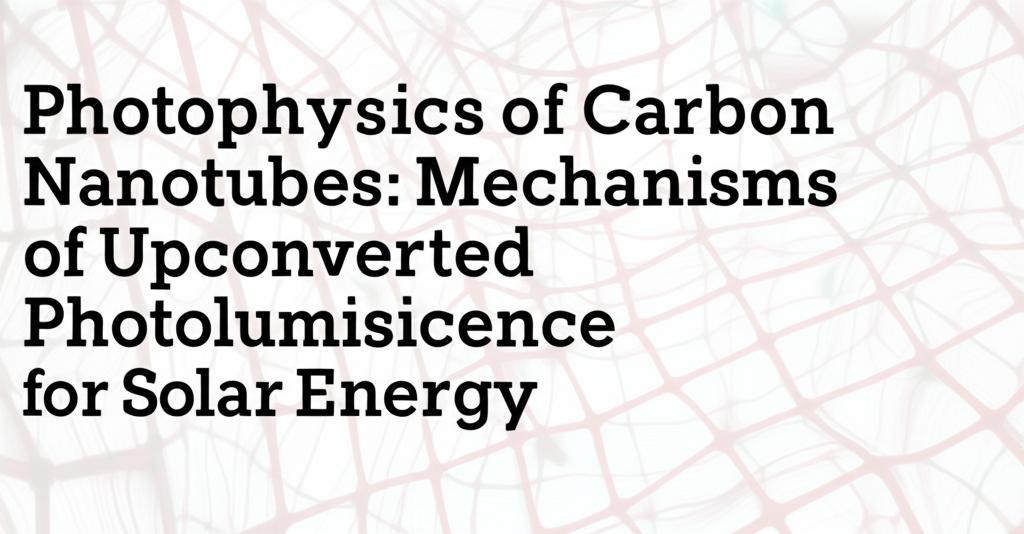The unique properties of carbon nanotubes (CNTs) have made them a compelling area of research, particularly for their potential in solar energy applications. One of the most intriguing aspects is their ability to exhibit upconverted photoluminescence (UCPL), a process where they absorb lower-energy light and emit higher-energy light. This phenomenon holds significant promise for boosting the efficiency of solar cells by enabling them to capture and utilize a broader spectrum of sunlight, including low-energy infrared photons that are typically wasted.
Understanding Photoluminescence and Upconversion:Typically, when a material undergoes photoluminescence, it absorbs high-energy light (like UV light), exciting electrons to higher energy levels. These excited electrons and the positively charged "holes" they leave behind form bound states called excitons. Eventually, the excitons recombine, releasing energy in the form of light that is lower in energy than the absorbed light. This is the principle behind fluorescent paints.
Upconversion photoluminescence (UCPL) is a rarer, counterintuitive process where materials absorb low-energy light and emit higher-energy light. In the context of solar energy, this means that currently unusable low-energy portions of the solar spectrum could be converted into higher-energy light that can be efficiently transformed into electricity by photovoltaic devices.
The Mechanism of Upconversion in Carbon Nanotubes:Recent research, particularly from scientists at RIKEN Center for Advanced Photonics, has shed light on the intrinsic mechanisms behind UCPL in single-walled carbon nanotubes (SWCNTs). The key to this process lies in the interaction between excitons and phonons, which are vibrations within the nanotube's crystal lattice.
Here's a breakdown of the newly understood intrinsic process:
- Excitation and Phonon Boost: When low-energy light (e.g., infrared light) strikes a carbon nanotube, it excites an electron. Simultaneously, this electron receives an energy boost from a phonon.
- Formation of "Dark Excitons": This combined energy input leads to the formation of a "dark exciton" state. Dark excitons are exciton states that do not efficiently emit light directly.
- Energy Adjustment and Emission: After a slight energy loss, this exciton transitions to a state from which it can efficiently emit light. Crucially, this emitted light possesses more energy than the initially absorbed light.
This intrinsic mechanism operates even in defect-free nanotubes, challenging previous theories that suggested defects were essential for UCPL in SWCNTs. The involvement of K-momentum phonon modes has been identified as central to this upconversion process.
Temperature's Role:Researchers have observed that increasing the temperature leads to a stronger UCPL effect. This supports the phonon-assisted model because phonons (lattice vibrations) become more abundant at higher temperatures. This increased availability of phonons enhances the probability of the phonon-mediated energy boost required for upconversion.
Implications for Solar Energy:The ability of carbon nanotubes to efficiently upconvert light offers several advantages for solar energy technologies:
- Enhanced Solar Cell Efficiency: By converting low-energy infrared photons (abundant in the solar spectrum but poorly utilized by conventional silicon-based solar cells) into higher-energy, usable photons, UCPL can significantly increase the overall power generation of solar cells.
- Broader Spectral Utilization: Solar cells incorporating UCPL materials could harvest a wider range of the solar spectrum, leading to better performance in various light conditions.
Beyond solar energy, the understanding of UCPL in carbon nanotubes opens doors to other advanced technologies:
- Biological Imaging: Upconverting nanoparticles are valuable in bio-imaging because near-infrared excitation light offers deeper tissue penetration and reduced autofluorescence compared to UV or visible light excitation.
- Photonic Devices: The ability to manipulate light energy in this way could lead to novel photonic devices.
- Optical Cooling: Researchers are exploring the possibility of using laser illumination to remove thermal energy from nanotubes via UCPL, a concept known as laser cooling.
The study of photophysics in carbon nanotubes, especially concerning UCPL, is an active and evolving field. Future research will likely focus on:
- Optimizing Efficiency: Further enhancing the efficiency of the upconversion process in various types of carbon nanotubes.
- Device Integration: Developing practical methods to integrate these upconverting carbon nanotubes into solar cell architectures and other optoelectronic devices.
- Engineering Excitation Pathways: Exploring how to engineer the interaction between light, excitons, and phonons to precisely control the upconversion process for specific applications.
- Exploring Different Nanomaterials: While this article focuses on carbon nanotubes, research into upconversion also extends to other nanomaterials like carbon quantum dots (CQDs) and rare-earth doped nanoparticles, each with unique mechanisms and potential applications.
The continued exploration of upconversion photoluminescence in carbon nanotubes holds the key to unlocking more efficient solar energy harvesting and developing next-generation photonic technologies. The refined understanding of the intrinsic mechanisms involving phonon coupling and dark excitons provides a solid foundation for these future advancements.

